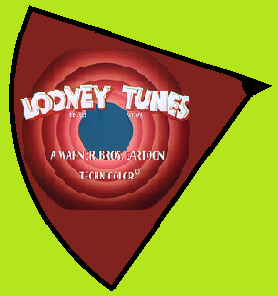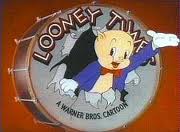
Looney Tunes is a Warner Bros. animated cartoon series. It preceded the Merrie Melodies series and was Warner Brothers' first animated theatrical series.[1] Since its first official release, 1930's Sinkin' in the Bathtub, the series has become a worldwide media franchise, spawning several television series, films, comics, music albums, video games and amusement park rides. The series features some of the most well-known and popular cartoon characters in history, including Bugs Bunny, Daffy Duck, Tweety Bird and Porky Pig. Many of the characters have made cameo appearances in television shows, films and advertisements. The name Looney Tunes is a variation on Silly Symphonies, the name of Walt Disney's concurrent series of music-based cartoon shorts. From 1942 until 1969, Looney Tunes was the most popular short cartoon series in theaters, exceeding Disney and other popular competitors.
History 1930–1969[]
In the beginning both Looney Tunes and Merrie Melodies drew their storylines from Warner's vast music library (notice the names Looney Tunes and Merrie Melodies). From 1934 to 1943, Merrie Melodies were produced in color and Looney Tunes in black and white. After 1943, however, both series were produced in color and became virtually indistinguishable, with the only stylistic difference being in the variation between the opening theme music and titles. Both series also made use of the various Warner Bros. cartoon characters. By 1937, the theme music for Looney Tunes was "The Merry-Go-Round Broke Down" by Cliff Friend and Dave Franklin; the theme music for Merrie Melodies was an adaptation of "Merrily We Roll Along" by Charles Tobias, Murray Mencher and Eddie Cantor.

In 1929, WB became interested in developing a series of musical animated shorts to promote their music. They had recently acquired the ownership of Brunswick Records along with four music publishers for US $28 million. Consequently, they were eager to start promoting this material to cash in on the sales of sheet music and phonograph records. Warner made a deal with Leon Schlesinger to produce cartoons for WB. Schlesinger hired Rudolph Ising and Hugh Harman to produce their first series of cartoons. Bosko was Looney Tunes' first major lead character, debuting in the short Bosko, The Talk-Ink Kid in 1929. The first Looney Tunes short was Sinkin' in the Bathtub which was released in 1930.[1] When Harman and Ising left Warner Bros. in 1933 over a budget dispute with Schlesinger, they took with them all the rights of the characters and cartoons which they had created.
A new character called Buddy became the only star of the Looney Tunes series for a couple of years. With the animators working in the Termite Terrace studio, they debuted the first truly major Looney Tunes star, Porky Pig, who was introduced in 1935 along with Beans the Cat in the Merrie Melodie cartoon I Haven't Got a Hat directed by Friz Freleng. Beans was the star of the next Porky/Beans cartoon Golddiggers of '49, but it was Porky who emerged as the star instead of Beans. The ensemble characters of I Haven't Got a Hat, such as Oliver Owl, and twin dogs Ham and Ex, were also given a sampling of shorts, but demand for these characters was far exceeded by Beans and Porky; Beans himself was later phased out due to declining popularity, leaving Porky as the only star of the Schlesinger studio. This was followed by the debuts of other memorable Looney Tunes stars such as Daffy Duck (in 1937) and the most famous of the Looney Tunes cast, Bugs Bunny (in 1940).
Bugs appeared mostly in the color Merrie Melodies series and formally joined the Looney Tunes crew with the release of Buckaroo Bugs. Schlesinger began to phase in the production of color Looney Tunes with the 1942 cartoon The Hep Cat. The final black-and-white Looney Tunes short was Puss n' Booty in 1943 directed by Frank Tashlin. The inspiration for the changeover was Warner's decision to re-release only the color cartoons in the Blue Ribbon Classics series of Merrie Melodies. Bugs Bunny made a cameo appearance in 1942 in the Avery/Clampett cartoon Crazy Cruise and also at the end of the Frank Tashlin 1943 cartoon Porky Pig's Feat which marked Bugs' only appearance in a black-and-white Looney Tunes short. Schlesinger sold his interest in the cartoon studio in 1944 to Warner Bros. and went into retirement - he would die five years later.
Stereotypes[]
A handful of Looney Tunes and Merrie Melodies shorts are no longer aired on American television nor are they available for sale by Warner Bros. because of the racial stereotypes of black people, Jews,[13] Native Americans, Asians such as Japanese (especially during WWII, as in Tokio Jokio and Bugs Bunny Nips the Nips), Chinese and Germans included in some of the cartoons. Eleven cartoons that prominently featured stereotypical black characters (and a few passing jokes about Japanese people, as in Coal Black and de Sebben Dwarfs and Jungle Jitters) were withdrawn from distribution in 1968 and are known as the infamous Censored Eleven.
In 1999 all Speedy Gonzales cartoons were banned because of their alleged stereotyping of Mexicans, though this was mild compared to the wartime portrayal of Japanese. When many Hispanics protested that they were not offended, and fondly remembered Speedy Gonzales cartoons as a representation of their youth and nation's individuality, these shorts were made available for broadcast again in 2002.[citation needed]
In addition to these most notorious cartoons, many Goldwyn cartoons contain fleeting or sometimes extended gags that reference then-common racial or ethnic stereotypes. The release of the Looney Tunes Golden Collection: Volume 3 includes a disclaimer at the beginning of each DVD in the volume given by Whoopi Goldberg which explains that the cartoons are products of their time and contain racial and ethnic stereotypes that "were wrong then and they are wrong today", but the cartoons are going to be presented on the DVD uncut and uncensored because editing them would be the same as denying that the stereotypes existed.
A written disclaimer, similar to the words spoken by Goldberg in Volume 3, is shown at the beginning of each DVD in the Looney Tunes Golden Collection: Volume 4, Volume 5, and Volume 6 sets, as well as the Daffy Duck and Foghorn Leghorn Looney Tunes Super Starssets: The cartoons you are about to see are products of their time. They may depict some of the ethnic and racial prejudices that were commonplace in the U.S society. These depictions were wrong then and they are wrong today. While the following does not represent the Warner Bros. view of today's society, these cartoons are being presented as they were originally created, because to do otherwise would be the same as claiming that these prejudices never existed.
Danske Stemmer[]
- Dennis Hansen – Snurre Snup & Pelle Gris
- Henrik Koefoed – Daffy And
- Vibeke Dueholm – Pip, Bedste
- Peter Zhelder - Sylvester
- Lasse Lunderskov – Elmer Fjot
- Ole Fick – Onkel Hans, Speedy Gonzales
- Thomas Mørk – Pepé Le Puh
- Lars Thiesgaard – Marvin, Tasmanske Djævel, Grimm E. Ulv
Awards
Inducted into to the National Film Registry[]
- What's Opera, Doc? (1957) selected in 1992
- Duck Amuck (1953) selected in 1999
- Porky in Wackyland (1938) selected in 2000
- One Froggy Evening (1955) selected in 2003
Academy Awards for Best Short Subject (Animation)[]
- Tweetie Pie (1947)
- For Scent-imental Reasons (1949)
- Speedy Gonzales (1955)
- Birds Anonymous (1957)
- Knighty Knight Bugs (1958)
Academy Award nominations[]
- It's Got Me Again! (1932)
- Detouring America (1939)
- A Wild Hare (1940)
- Hiawatha's Rabbit Hunt (1941)
- Rhapsody in Rivets (1941)
- Pigs in a Polka (1943)
- Greetings Bait (1943)
- Swooner Crooner (1944)
- Life with Feathers (1945)
- Walky Talky Hawky (1946)
- Rhapsody Rabbit (1946)
- Mouse Wreckers (1949)
- From A to Z-Z-Z-Z (1953)
- Sandy Claws (1955)
- Tabasco Road (1957)
- Mexicali Shmoes (1959)
- Mouse and Garden (1960)
- High Note (1960)
- Beep Prepared (1961)
- Nelly's Folly (1962)
- Now Hear This (1963)
Licensing and ownership
When the Looney Tunes and Merrie Melodies began in 1930, although Warner Bros. retained the rights to the cartoons, Harman and Ising owned the rights to the Bosko characters. When Harman and Ising left Warner Bros. in 1933, their former producer Leon Schlesinger started his own studio for Warner Bros. continuing the Looney Tunes series. Harman and Isning retained the rights to Bosko and began making Bosko cartoons at Metro-Goldwyn-Meyer in 1935. However theese cartoons were not a sucsess and in 1937 MGM fired Harman and Isning and purchased thier studio to create MGM cartoons, thus obtaining the rights to Bosko. Meanwhile the Schlesinger studio continued to make popular cartoons until 1944 when Schlesinger sold his studio to Warner Bros. and since then, Warner Bros. has owned all rights to all post-1933 characters created by Leon Schlesinger Productions and Warner Bros. Cartoons. The rights to individual cartoons however are in other hands.
In the early 1950s, Warner Bros. sold its black-and-white Looney Tunes (plus the black-and-white Merrie Melodies made after Harman and Ising left) into television syndication through their subsidiary Sunset Productions. These cartoons were distributed by Guild Films until it went bankrupt and shut down in 1961. Warner Bros. then licensed the syndication rights to Seven Arts Associated, who distributed them until their purchase of Warner Bros. in 1967.
In 1956, Associated Artists Productions (a.a.p.) acquired for television most of Warner Bros' pre-1950[14][15] library, including all Merrie Melodies (except for those sold to Sunset and Lady, Play Your Mandolin!) and color Looney Tunes shorts that were released prior to August 1948. Unlike the sale to Sunset Productions, a.a.p. was allowed to keep the Warner titles intact and simply inserted an "Associated Artists Productions presents" title at the head of each reel (as a result, each Merrie Melodie cartoon had the song "Merrily We Roll Along" playing twice).[16] a.a.p. was later sold to United Artists, who merged the company into its television division—United Artists Television.
In 1981, UA was sold to Metro-Goldwyn-Meyer, and five years later, Ted Turner acquired the pre-May 1986 MGM library—which included the rights to MGM's cartoon characters like Tom and Jerry and Bosko. He also aquired the rights to the a.a.p. library. In 1996, Turner's company, Turner Broadcasting System (whose Turner Entertainment division oversaw the film library), was purchased by Time Warner who also owned Warner Bros.. Today, Warner Home Video holds the video rights to the entire Looney Tunes/Merrie Melodies animated output by virtue of Time Warner's ownership of Turner Entertainment—this is why their Looney Tunes Golden Collection DVD box sets include cartoons from both the pre-8/48 Turner-owned and post-7/48 Warner Bros. owned periods. As of 2012, all Warner Bros' animated output are under the same Time Warner umbrella of ownership.
Broadcast history
Starting in 1960, the cartoons were repackaged into several different TV programs that remained popular for several decades before being purchased by Turner Broadcasting Systems.[17] Turner's Cartoon Network reran the cartoons for 12 years, from their start in 1992 until 2004, when the cartoons were removed from the schedule. In November 2009, Cartoon Network brought back reruns of Looney Tunes shorts.
Copyright: http://en.wikipedia.org/wiki/Looney_Tunes

Merrie Melodies & Looney Tunes - Opening themes.
Shows Intro
